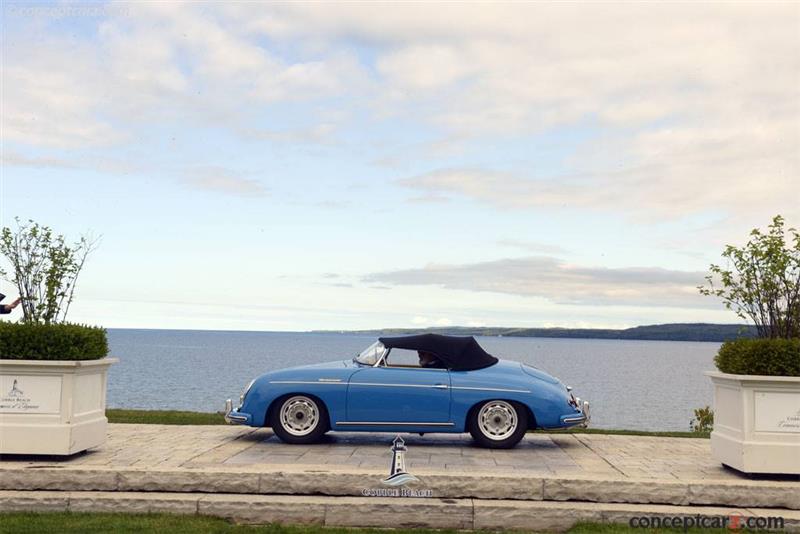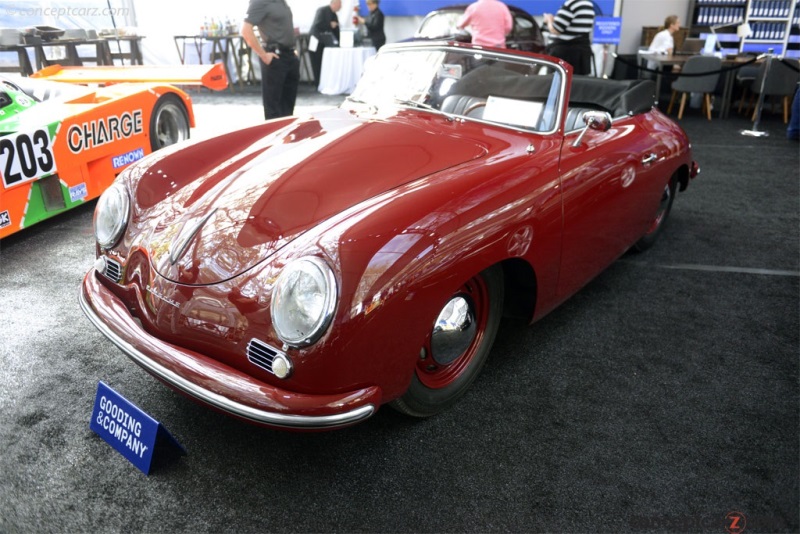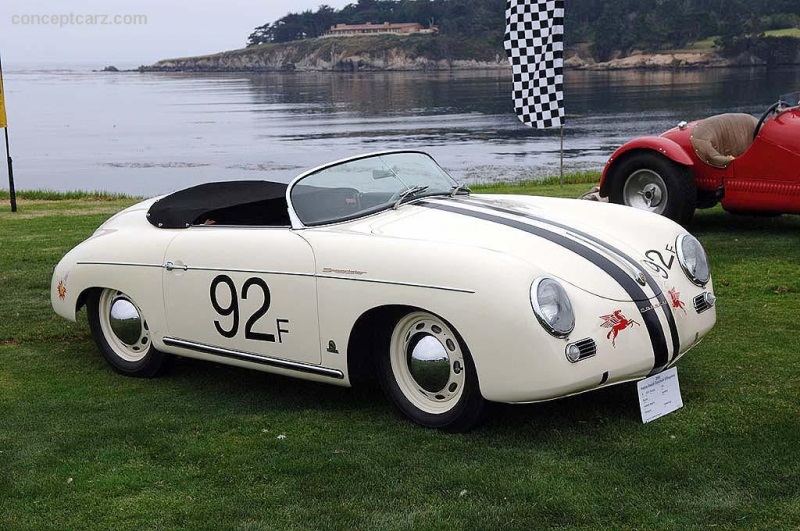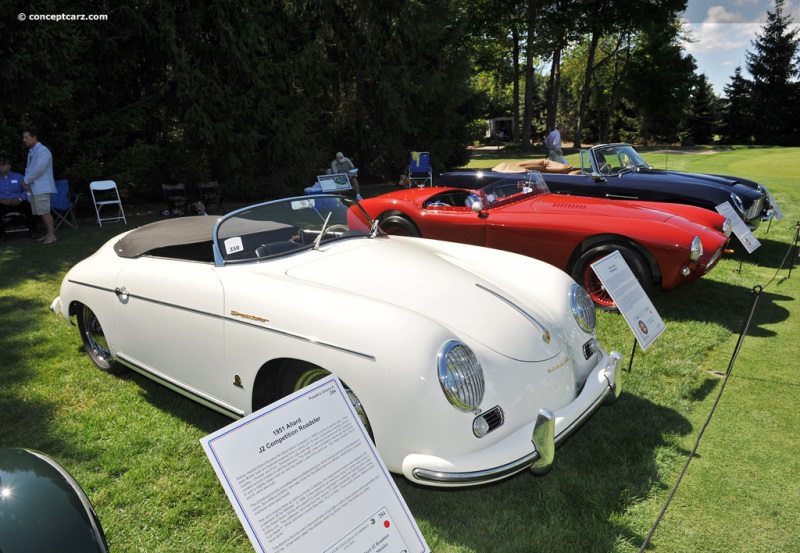1954 Porsche 356 Navigation
Ferdinand Porsche established his automotive design consultancy in the early 1930s but his name would not appear on a car until 1948. Small, light, rear-engined, and highly maneuverable, the 356 set the standard by which all other Porsches have been built. It was unique, fresh, and new in every way, and introduced the world to a new concept in sports car design. A collaboration between `Ferry' Porsche, the son of the company's founder, and its chief body engineer Erwin Komenda, the very early examples of the 356 wore handcrafted bodies from aluminum in Gmund, Austria. Parts and material were in short supply following World war II, and the model initially employed the engine, suspension, and transmission from the Volkswagen Beetle - the car designed by Porsche Senior. Like the Beetle, it had a platform-type chassis with a rear-mounted air-cooled flat-four cylinder engine with a 1,100cc displacement and torsion bar all-independent suspension. Within two years, however, the car had been considerably re-engineered and used fewer stock Volkswagen parts, the bodies were made of steel, and production had relocated to Zuffenhausen in Germany. 
Speedster by Reutter Karosserie
Chassis #: 80032
Engine #: 33688
View info and history
Auction entries : 1Large-scale production of the 356 was never Porsche's intention and early 356 examples were sold primarily in Austria and Germany. It had taken Porsche two years, starting with the first prototype in 1948, to manufacture the first 50 automobiles. It quickly gained a reputation among enthusiasts on both sides of the Atlantic for its aerodynamics, handling, and excellent build quality. This was further bolstered by successes in such top events as Le Mans, the Mille Miglia, Targa Florio and Carrera Panamericana, as well as countless other races and rallies around the world. In 1951, a works car finished first in the 1,100cc class at the Le Mans 24-Hour Race, the first of a long and illustrious association with La Sarthe.Porsche continued to develop and refine the 356 during its production lifespan, with the original split windscreen replaced by a one-piece, a Porsche synchromesh gearbox was eventually adopted, and the 356's engine enlarged first to 1.3 and then to 1.5 liters. A cabriolet body style followed on the heels of the original 356 Coupe and then in 1952, the U.S. importer Max Hoffman received a trial batch of 15 roadsters. Hoffman had persuaded Porsche of the potential for an entry-level, lower-priced model, and although skeptical at first, were convinced following the successful reception in the U.S. This led to the introduction of the Speedster model in 1954. The inspiration of the Speedster is also credited to John Von Neumann, Porsche's West Coast distributor, who had chopped down a Gmünd-built Coupe in the late 1940s to create a lightweight competition car. At the time, Porsche's contracted body manufacturer Reutter lacked the proper stamping dies in place to produce the Speedster, so Porsche used what it had at its disposal. The first 200 Speedsters built in 1954 were based on Cabriolets whose windshield posts were simply cut off. Many of these early examples retained the mounting points on the rear quarter wheel housings for the Cabriolet's folding canvas top. By 1955, the early issues had been resolved, and Reutter began manufacturing 356 Speedster bodies in earnest. 
Speedster by Reutter Karosserie
View info and historyThe Speedster was built as a minimalistic and cheaper/economy model intended to compete with the less-expensive British sports cars. Distinguishable features of the Speedster to its Cabriolet sibling were its low, wraparound windscreen, lower door waistline, smaller and entirely retractable top, and horizontal trim strip at the level of the door handles. The interior carried twin bucket seats which further emphasized its sporting image. Power was initially sourced from the 1.5-liter version of Porsche's horizontally opposed four, gaining the new 1.6-liter, 60 horsepower engine with the introduction of the improved 356A for 1955. The development of the 356 was charted by the suffixes A, B and C. The 'Super' option delivered 75 horsepower, which was 25-percent more power than the standard 1.6-liter motor. Priced at $2,995, the Speedster was the lightest of the 356s with a top speed in excess of 100 mph. The affordable price, attractive styling, and renowned handling characteristics made the Speedster an instant success in the burgeoning American sports car racing scene. Between 1954 and 1958, Porsche produced 4,822 examples of the Speedster. The Porsche 356 produced from 1948 to 1955 are known as 'pre-A.' In late 1955, after receiving numerous significant changes, the 356 'A' was introduced and would remain in production through 1959. The internal factory designation was 'Type 1,' thus its 'T1' nickname among enthusiasts. Styling and technical refinements gave birth to the 356 'B' in 1960 and continued in production through 1963. The final revision of the 356 was the 356 'C' which was built in 1964 and 1965.The early Porsche 356 was powered by a 1,100cc engine, which grew to 1,300 and 1,500cc displacement sizes in 1951. The split windscreen was replaced by a slightly 'V'-shaped, single windshield design in late 1952. The 1,100cc engine was dropped in 1953, the same year Porsche introduced the 1300 S or 'Super.' 
Coupe 2+2
Chassis #: 51094The horizontally opposed, air-cooled, overhead-valve four-cylinder engine had cast-iron cylinder liners, four main bearings, and solid valve lifters. In 1,086cc configuration and with the help of two Solex carburetors and 7.0:1 compression, it developed approximately 46 (SAE) horsepower at 4,000 RPM and 51 lb-ft of torque at 2,800 RPM. The 1,286cc displacement version also used two Solex carburetors with a 6.5:1 compression and produced 50 (SAE) horsepower at 4,000 RPM and 59 lb-ft of torque. The optional 1300 'S' version had 8.2:1 compression and produced 70 (SAE) hp at 5,500 RPM and 63 lb-ft at 3,600 RPM. The 1,488cc displacement size had 6.5:1 compression, two Solex carburetors, and produced 64 (SAE) hp at 4,400 RPM and the 1500 'Super' brought horsepower to 82 (SAE) and 79 lb-ft of torque. The four-cylinder engine was backed by a four-speed manual transmission which was initially non-synchromesh. Steering was by worm and peg and braking by hydraulic drum brakes at all four corners. The chassis was a steel unibody with a boxed, press-steel platform with a wheelbase of 82.7-inches. The suspension used parallel trailing arms with transverse laminated torsion bars in the front while the rear had swing axles with transverse torsion bars. From its debut in the late 1940s through its retirement in 1965 when it was replaced by the 911 (which had been introduced in September of 1964), Porsche built approximately 76,000 examples of the 356.
by Daniel Vaughan | Apr 2009
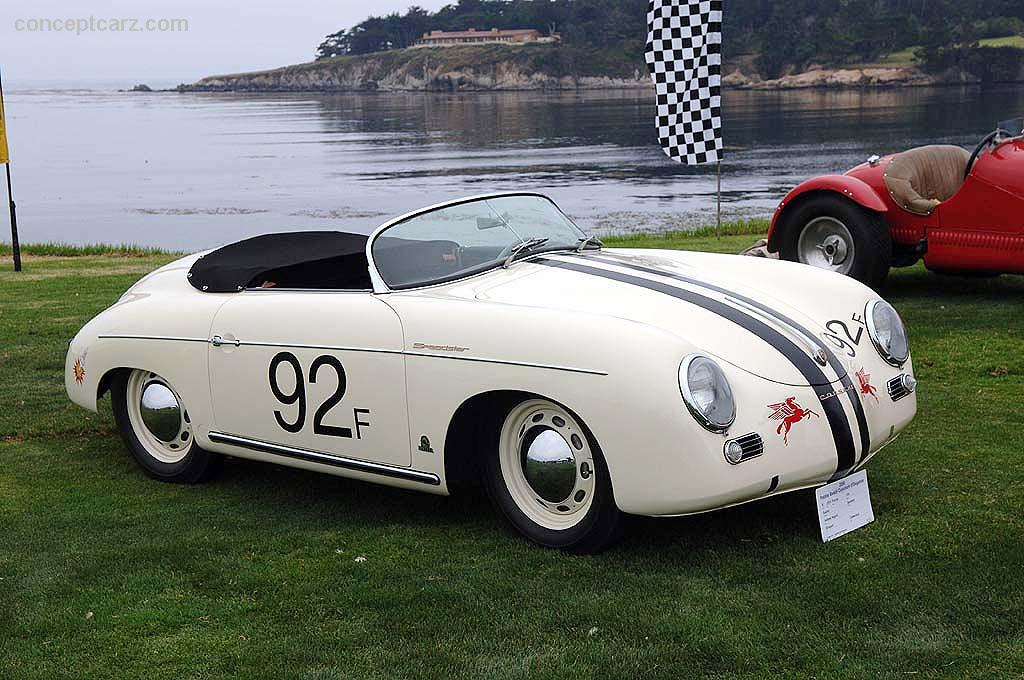
Speedster by Reutter Karosserie
Chassis #: 80032
Engine #: 33688
View info and history
Auction entries : 1
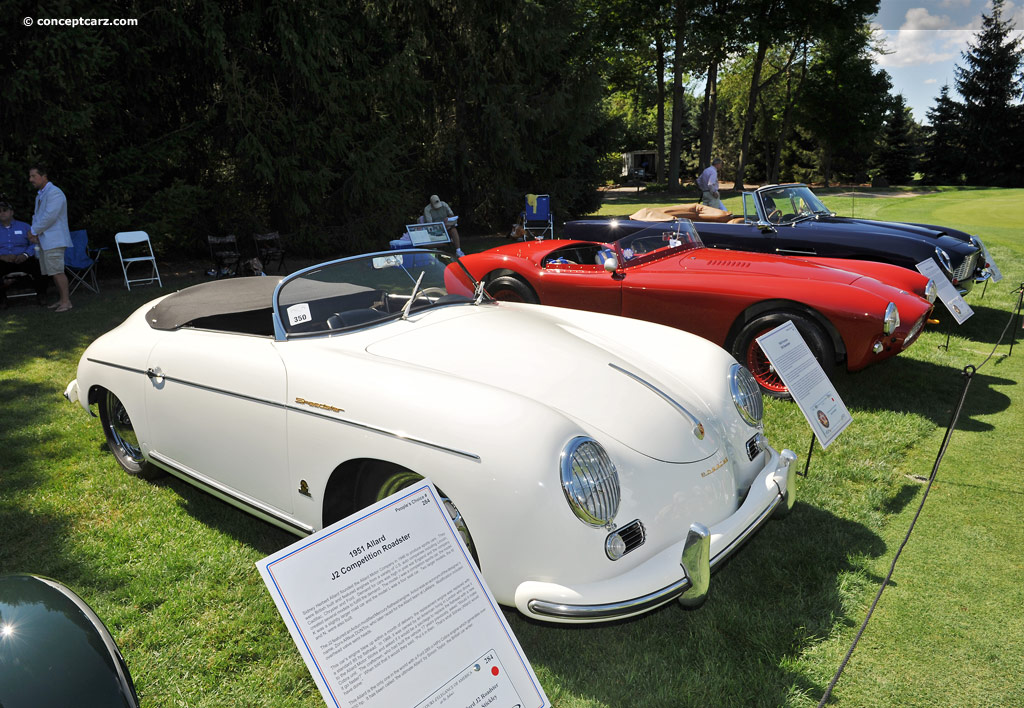
Speedster by Reutter Karosserie
View info and history
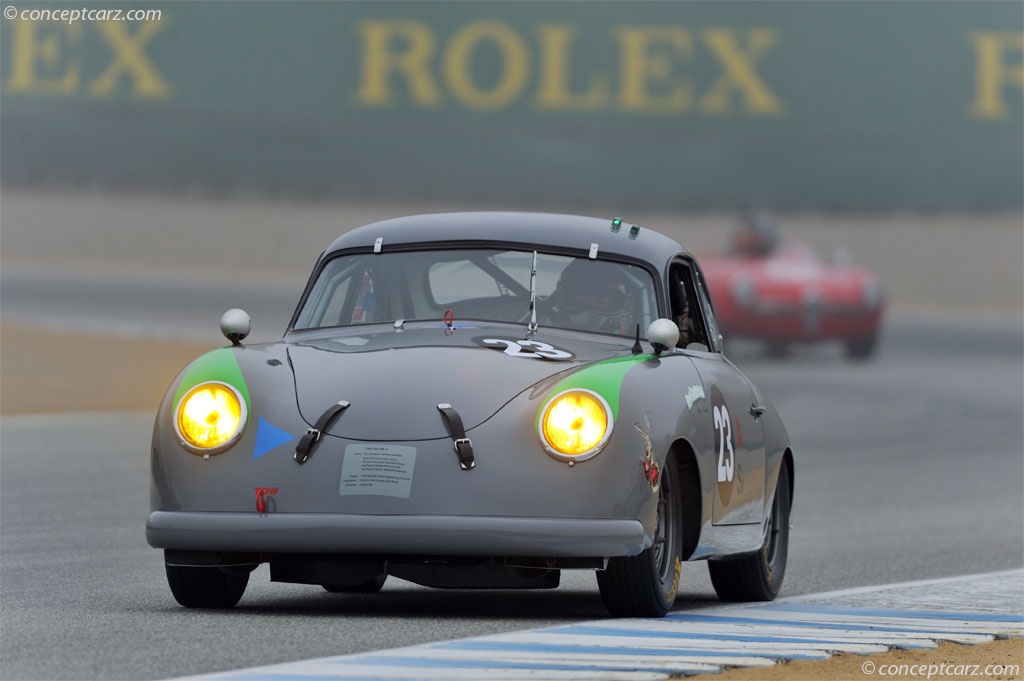
Coupe 2+2
Chassis #: 51094
by Daniel Vaughan | Apr 2009
Related Reading : Porsche 356 History
During the war, Ferdinand Ferry Porsche and a handful of his proven, faithful employees had started work on development number 356 in their workshops moved to the town of Gmünd in Karnten. The first design drawings were completed on 17 July 1947, and on 8 June 1948, the Karnten state government issued a special permit homologating the car. Returning home after being held by the French as a prisoner....
Continue Reading >>
Continue Reading >>
Related Reading : Porsche 356 History
The Porsche 365C has been named the number ten on the list of Top Sports Cars of the 1960s by Sports Car International in 2004. The Porsche 356 is still widely regarded as a collector car that has capably stood the test of time. There is some debate over which vehicle was the first official Porsche, the pre-war Porsche 64 being actually a VW racing automobile. The 356 was a sports car designed....
Continue Reading >>
Continue Reading >>
- 1954 Porsche 356 Menu
- Article
- Image gallery
- Valuation
- Specifications
- Profiles
- Production figures
Porsche
Similar Vehicles
Similar Automakers
Similarly Sized Vehicles
from 1954
- AC Ace
Alfa Romeo 1900
Arnolt Bolide
Aston Martin DB2/4
Austin-Healey 100-4 BN1
Citroen Traction Avant
Huffaker Marston Healey Special
Jaguar Type D
Jaguar XK140
Maserati A6 GCS
Similarly Priced Vehicles
1954 Porsche 356 Vehicle Profiles
Recent Vehicle Additions
Related Automotive News
76Th Goodwood Members' Meeting Races Unveiled
Fresh from planting 100,000 new bulbs to join the host of golden daffodils that will flutter and dance around the Goodwood Motor Circuit next spring, the Goodwood Team is thrilled to reveal the races that will make up the 76th Members Meeting programme...

Gooding & Company is Honored to Present a One-off Supercharged Mercedes-Benz
High-Style Highlights Include The 1928 Mercedes-Benz Type S 26180 Sports Tourer for Sale for the First Time in 53 Years, The 1939 Bugatti Type 57C Cabriolet with the Final Type 57 Chassis Number, The 1937 Maserati 6CM Formerly the Property of Racer...
1958 Targa Florio: Musso Commands the Heights
During the invasion of Sicily during the Second World War it would be the mountainous roads around the island that would pose the greatest hindrance to the advance of the British and American forces trying to breakthrough on their way, ultimately, to...

Techno Classica 2014: more than 30 racing cars to celebrate 120 years of Mercedes-Benz motor racing history
Cars that were the heroes of magical moments put their stamp on this high-powered, most comprehensive show presentation
With more than 30 vehicles, Mercedes-Benz Classic presents motor racing history in all its unique breadth and depth
120 years o...

Goodwood Festival of Speed 2013: auction of Mercedes-Benz W 196 R one of highlights at world's 'largest motorised garden party'
Mercedes-Benz Classic presents great moments in motor-racing history at Goodwood
Motorsport festival celebrating its 20th anniversary
Auction of only privately owned post-war Silver Arrow by Bonhams sure to cause a stir
Stuttgart – This...


























